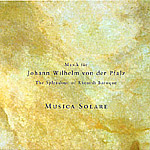If asked what common thread exists between Arcangelo Corelli, Francesco Bonporti, Handel, and Johannes Schenck, it’s unlikely that anyone would answer that all were passing acquaintances of Count Johann Wilhelm von der Pfalz. Nor would Dusseldorf likely be anyone’s first choice as an inspirational setting where these composers created their most “splendid” works. However, whatever measure of dubious thematic focus and/or happenstance got the ball rolling to create this program, it’s peripheral to the beauty of the music and lovely performances throughout by the Aächen-based Musica Solare.
Arguably the most common work offered here, Corelli’s second Concerto grosso from his famous Op. 6, in fact receives a refreshingly different rendering–a surprisingly intimate chamber account equally as expressive, elegant, and engaging as my reference orchestral versions by Ensemble 415 (Harmonia Mundi) and La Petite Bande (Duetsche Harmonia Mundi). Other welcome surprises include premiere recordings of two Concerti a Quattro in D minor and D major attributed to Handel (though some observers believe Telemann to be the composer). Regardless of who penned these delicacies, both feature many exemplary moments that would have done either composer proud.
Not surprisingly, the works by the lesser-known composers Schenck and Bonporti satisfy the least. Though neatly written with its share of virtuosic passages, Schenck’s Sonata No. 3 offers little imaginative use of the Italian models on which it was based. Musica Solare’s performance of Bonporti’s Inventione No. 1 from his Op. 10 fares somewhat better with a couple of extraordinarily lively dance movements–the 39-second Aria: Allegro and final Bizaria: Andante are gems. Listeners desiring more of Bonporti’s eccentricity would do well to acquire Chiara Banchini’s ravishing complete Op. 10 on Harmonia Mundi. As usual with Marc Aurel recordings, the presentation is austerely lovely and the sonics are excellent. Stefan Schwarzer’s notes are informative and fair, especially given the occasionally shaky relationship between the pieces performed here and the Count. Warmly recommended.
































